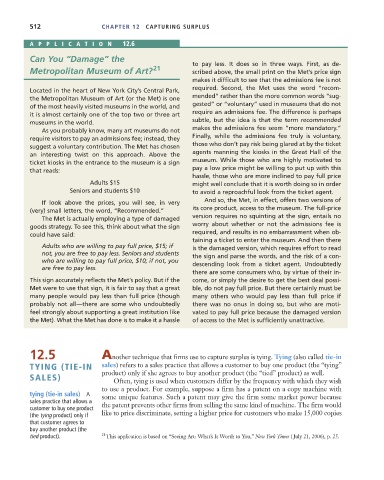Page 538 - Microeconomics, Fourth Edition
P. 538
c12capturingsurplus.qxd 7/22/10 10:41 AM Page 512
512 CHAPTER 12 CAPTURING SURPLUS
APPLICA TION 12.6
Can You “Damage” the
to pay less. It does so in three ways. First, as de-
Metropolitan Museum of Art? 21 scribed above, the small print on the Met’s price sign
makes it difficult to see that the admissions fee is not
Located in the heart of New York City’s Central Park, required. Second, the Met uses the word “recom-
the Metropolitan Museum of Art (or the Met) is one mended” rather than the more common words “sug-
of the most heavily visited museums in the world, and gested” or “voluntary” used in museums that do not
it is almost certainly one of the top two or three art require an admissions fee. The difference is perhaps
museums in the world. subtle, but the idea is that the term recommended
As you probably know, many art museums do not makes the admissions fee seem “more mandatory.”
require visitors to pay an admissions fee; instead, they Finally, while the admissions fee truly is voluntary,
suggest a voluntary contribution. The Met has chosen those who don’t pay risk being glared at by the ticket
an interesting twist on this approach. Above the agents manning the kiosks in the Great Hall of the
ticket kiosks in the entrance to the museum is a sign museum. While those who are highly motivated to
that reads: pay a low price might be willing to put up with this
hassle, those who are more inclined to pay full price
Adults $15 might well conclude that it is worth doing so in order
Seniors and students $10 to avoid a reproachful look from the ticket agent.
If look above the prices, you will see, in very And so, the Met, in effect, offers two versions of
(very) small letters, the word, “Recommended.” its core product, access to the museum. The full-price
The Met is actually employing a type of damaged version requires no squinting at the sign, entails no
goods strategy. To see this, think about what the sign worry about whether or not the admissions fee is
could have said: required, and results in no embarrassment when ob-
taining a ticket to enter the museum. And then there
Adults who are willing to pay full price, $15; if is the damaged version, which requires effort to read
not, you are free to pay less. Seniors and students the sign and parse the words, and the risk of a con-
who are willing to pay full price, $10; if not, you descending look from a ticket agent. Undoubtedly
are free to pay less.
there are some consumers who, by virtue of their in-
This sign accurately reflects the Met’s policy. But if the come, or simply the desire to get the best deal possi-
Met were to use that sign, it is fair to say that a great ble, do not pay full price. But there certainly must be
many people would pay less than full price (though many others who would pay less than full price if
probably not all—there are some who undoubtedly there was no onus in doing so, but who are moti-
feel strongly about supporting a great institution like vated to pay full price because the damaged version
the Met). What the Met has done is to make it a hassle of access to the Met is sufficiently unattractive.
12.5 Another technique that firms use to capture surplus is tying. Tying (also called tie-in
TYING (TIE-IN sales) refers to a sales practice that allows a customer to buy one product (the “tying”
product) only if she agrees to buy another product (the “tied” product) as well.
SALES) Often, tying is used when customers differ by the frequency with which they wish
to use a product. For example, suppose a firm has a patent on a copy machine with
tying (tie-in sales) A some unique features. Such a patent may give the firm some market power because
sales practice that allows a the patent prevents other firms from selling the same kind of machine. The firm would
customer to buy one product
(the tying product) only if like to price discriminate, setting a higher price for customers who make 15,000 copies
that customer agrees to
buy another product (the
tied product). 21 This application is based on “Seeing Art: What’s It Worth to You,” New York Times ( July 21, 2006), p. 25.

